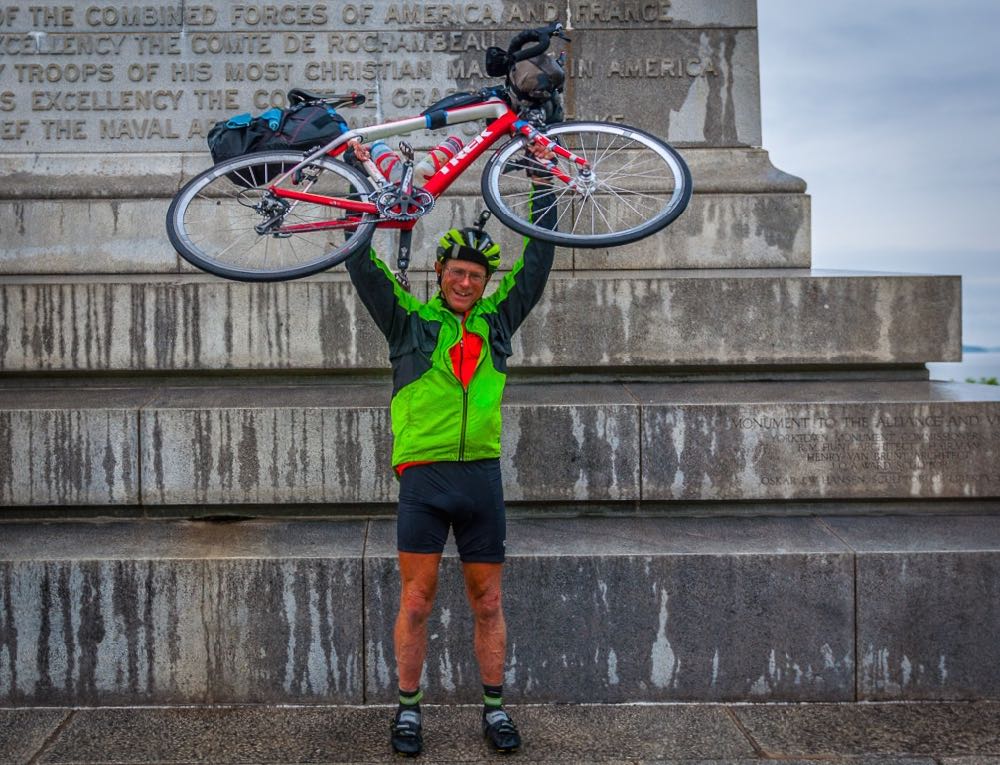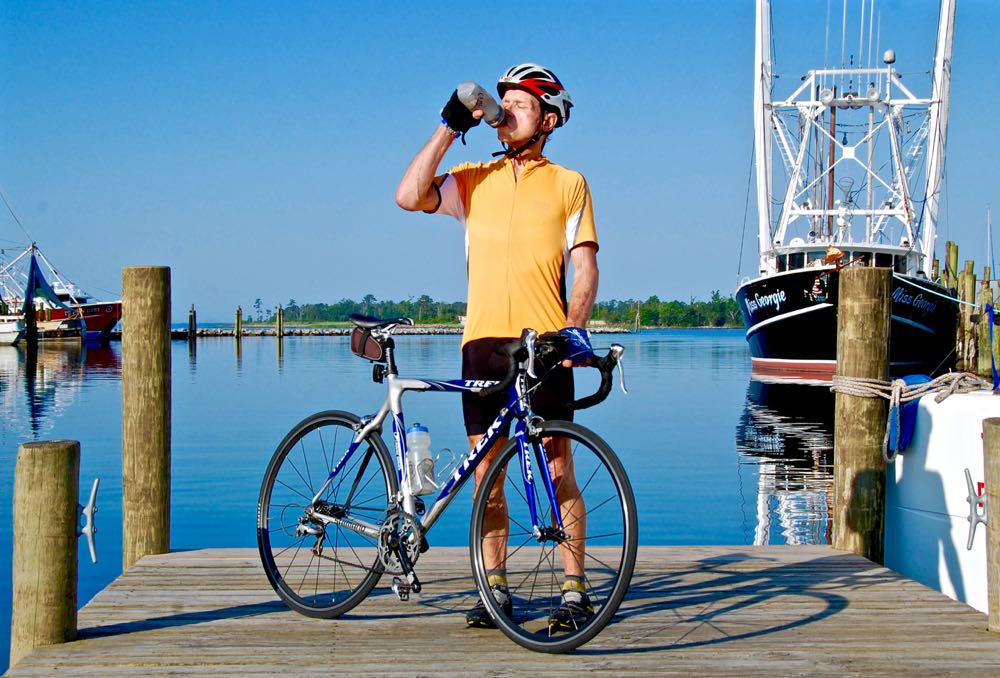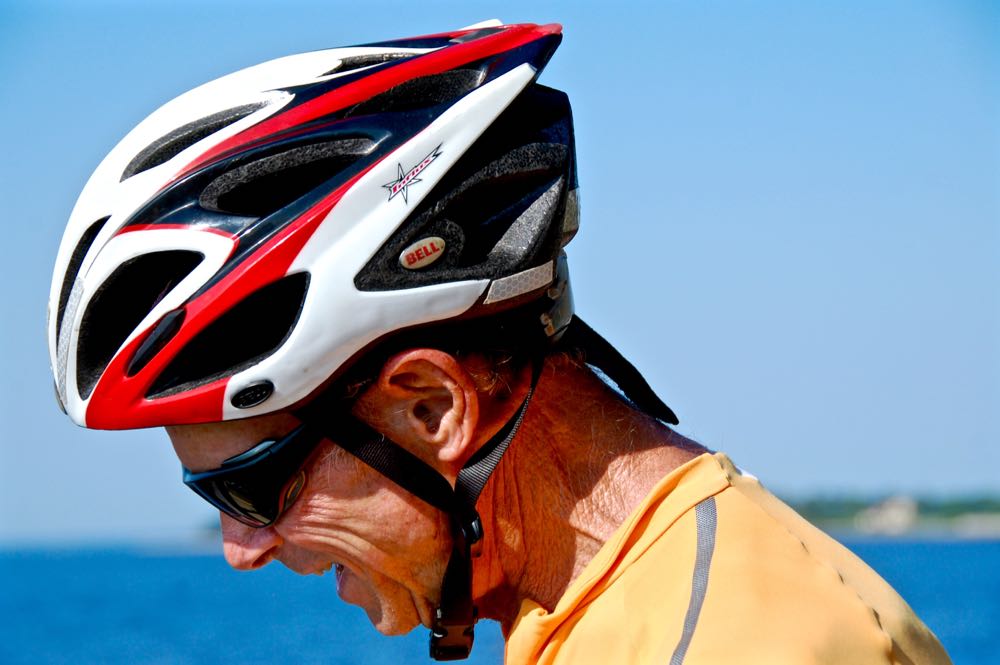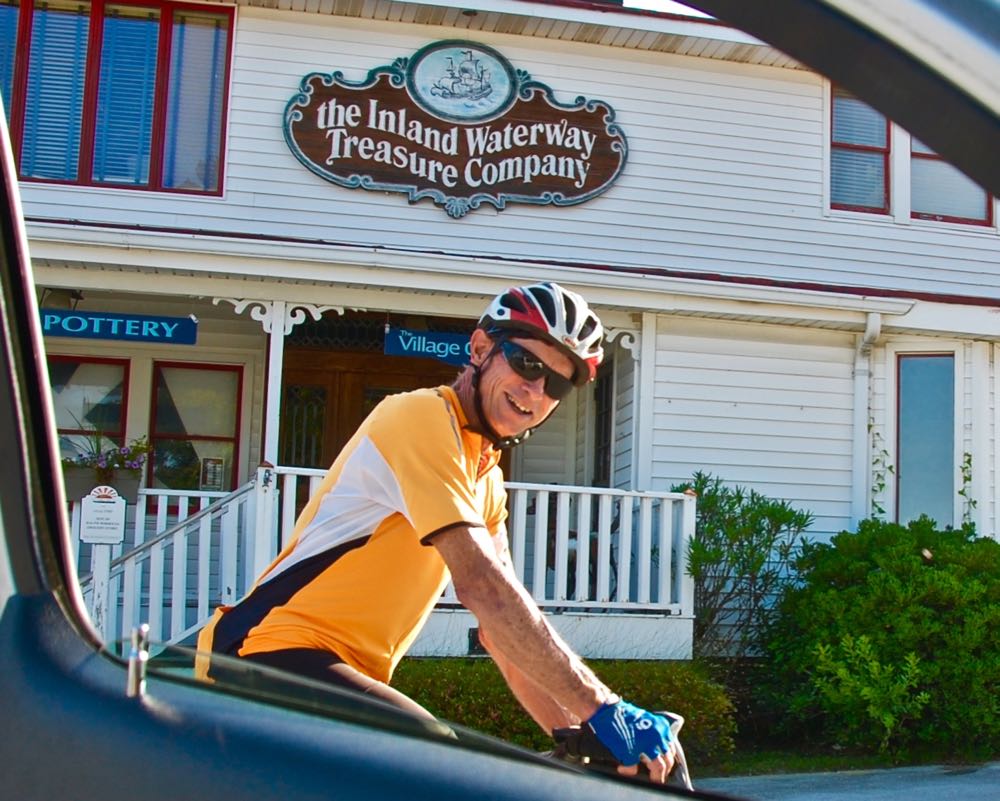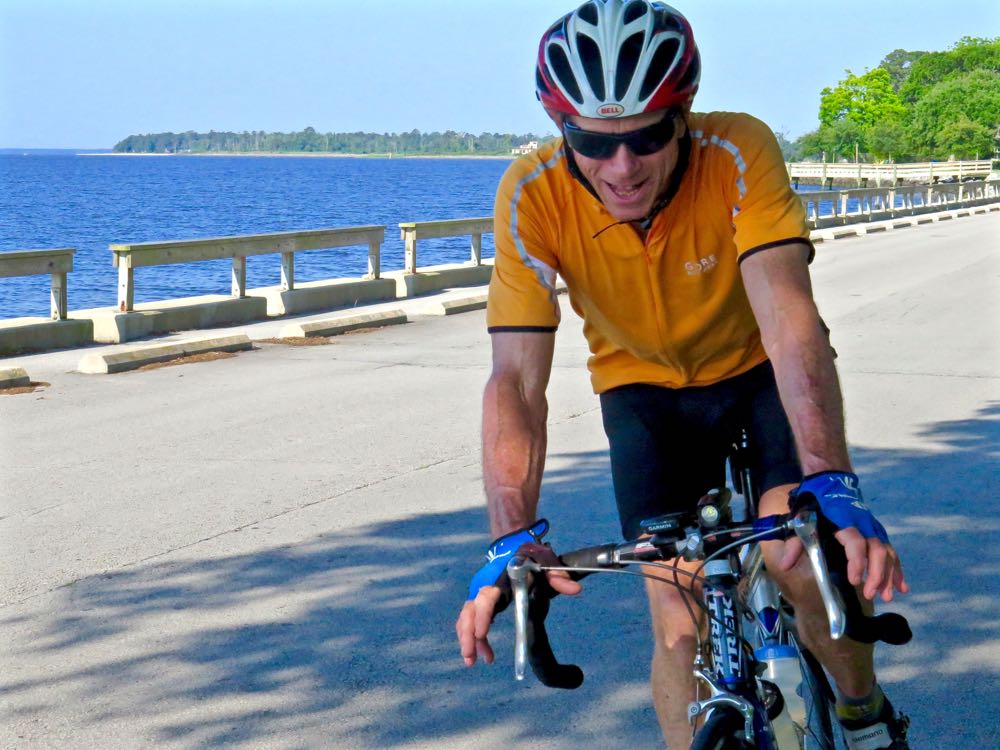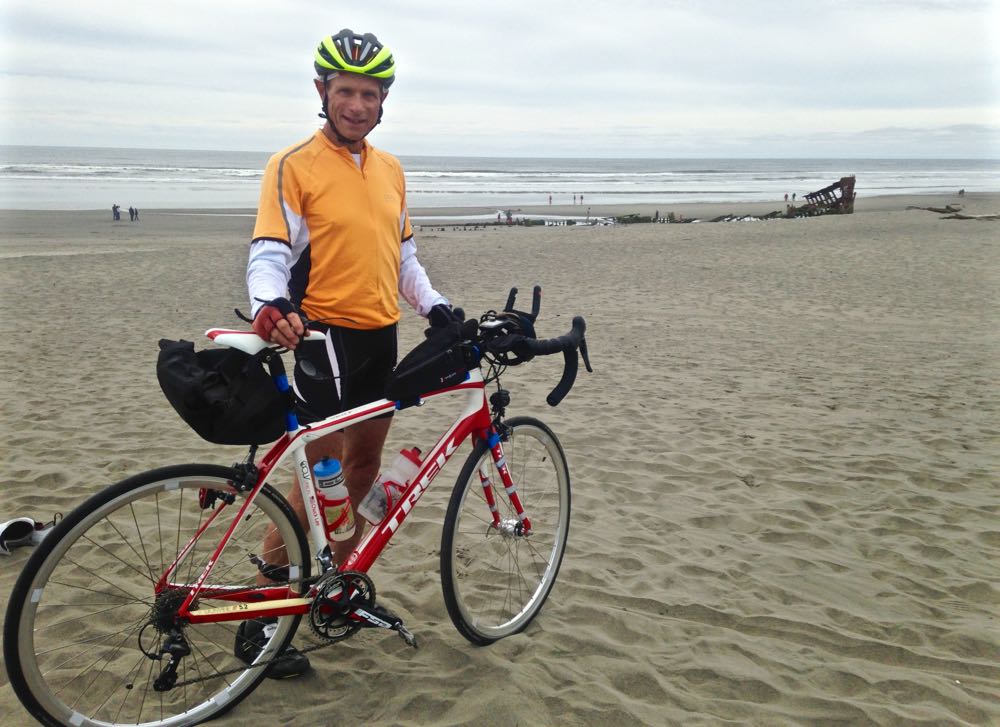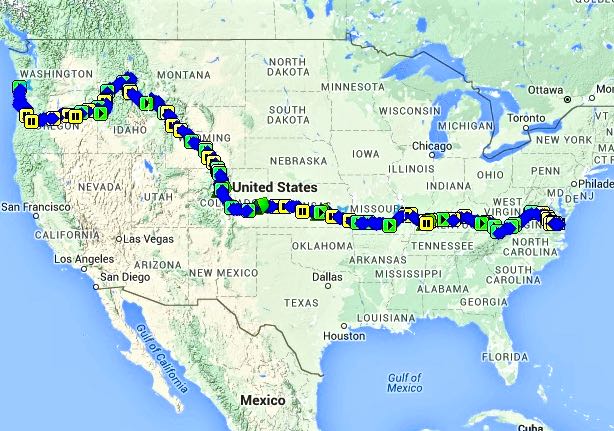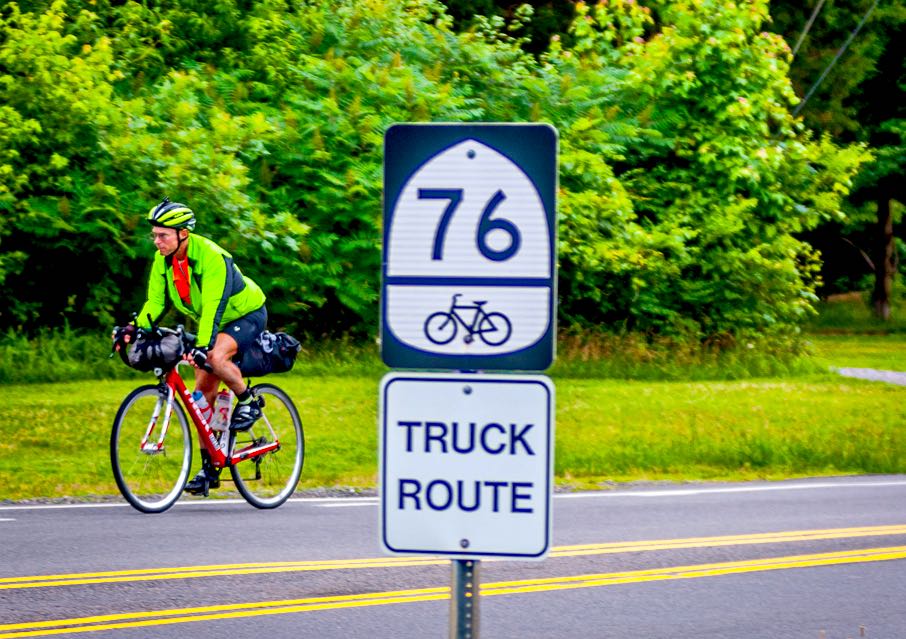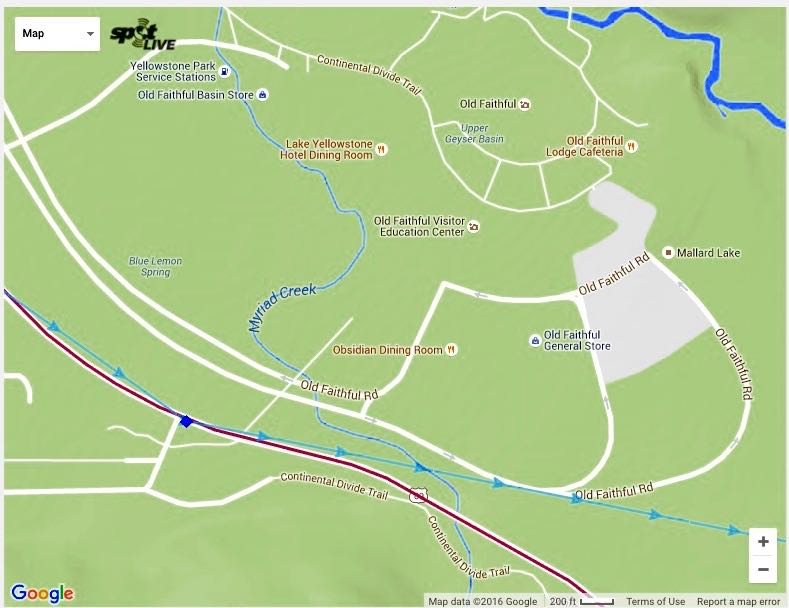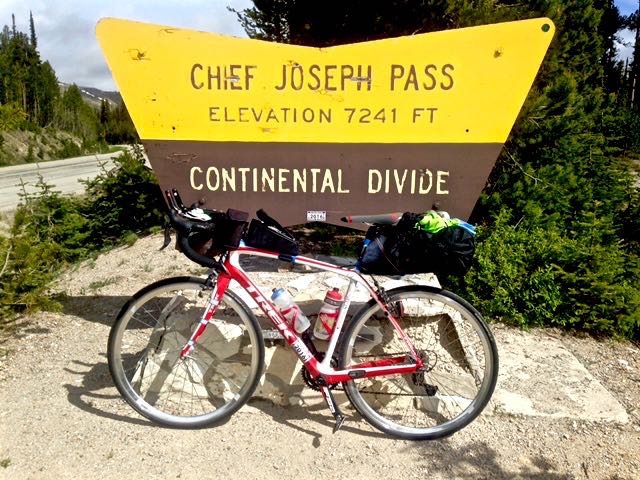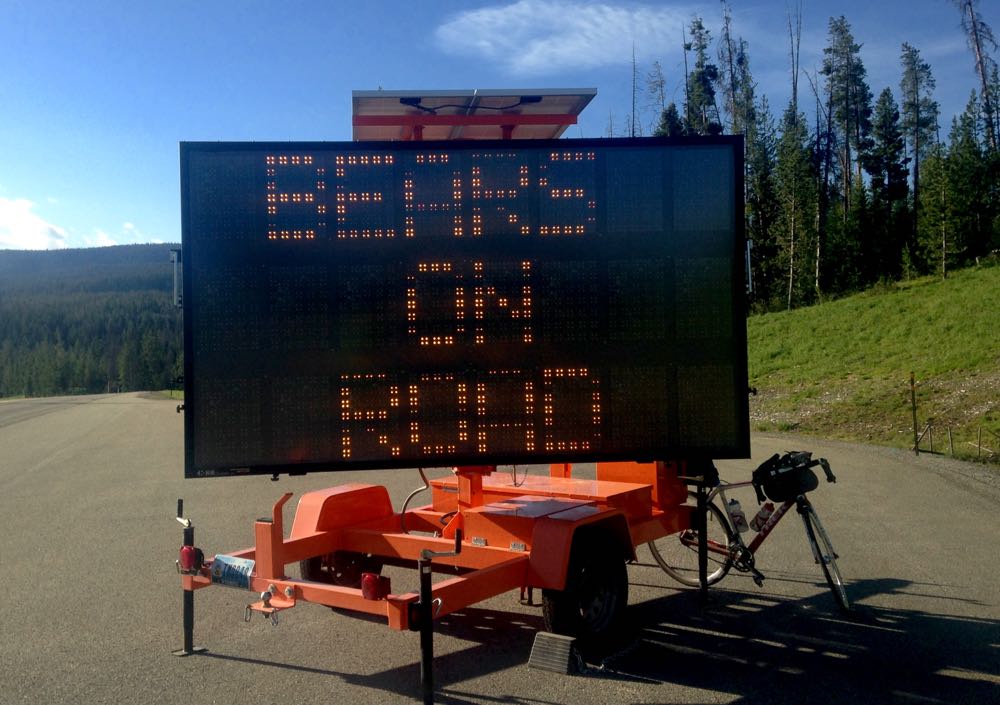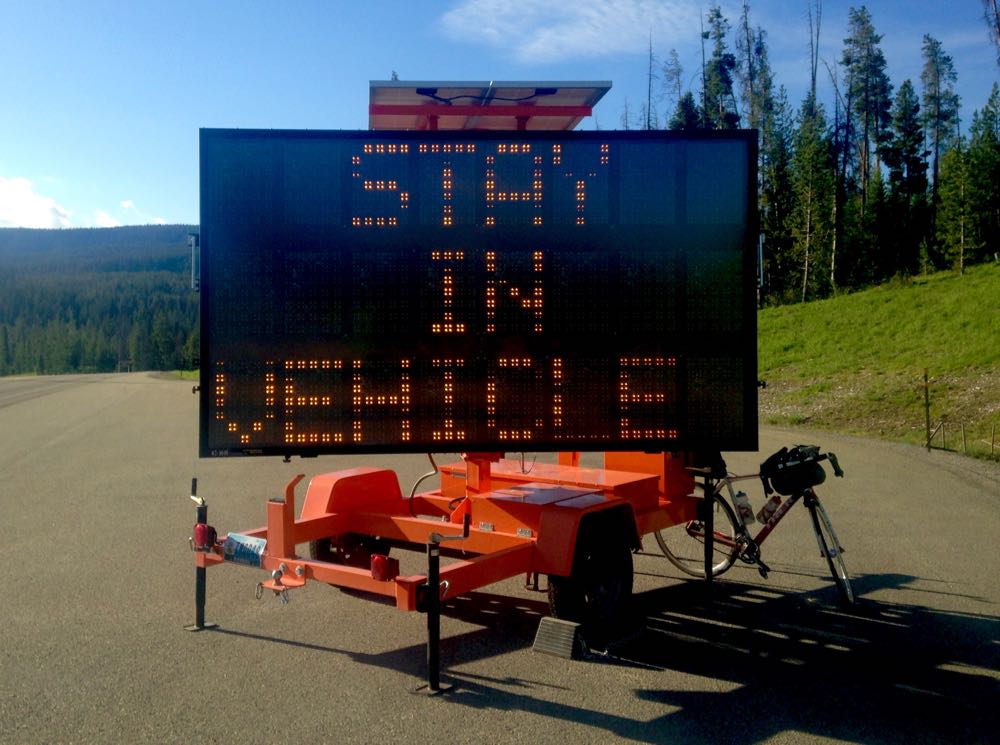It's Friday April 19, 2024
News From The Village Updated Almost Daily
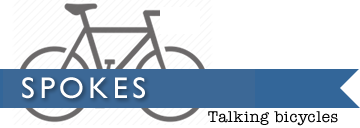
July 2016
Just before 7a on July 4th, Chuck Lee pedaled his red and white bicycle into the center of Yorktown, Virginia. And with not much fanfare, finished a very long race.Chuck Lee hoists his bike, a Trek Domane over head at the monument in Yorktown, VA on the fourth of July. He’d just completed the 4269 miles from Oregon in under 30 days. (Photo. D Kramer)Exactly one month earlier – on June 4th at 11a EST – Chuck got on his bike in Astoria, Oregon and with about 5 dozen other cyclists, set out in this 3rd Annual Trans Am Bike Race. With his early morning finish on the Fourth of
July at Yorktown, the Arapahoe resident covered 4269 miles in just under 30 days.While the TransAm Bike Race is a relatively new thing, the Trans America bike route is not. The sometimes meandering network of back roads turned 40 this year. When the TransAm was set up for the 1976 Bicentennial, some of the racers in this year’s race were not yet born.
That’s not the case for Chuck Lee. He appears to be the oldest racer to finish this year’s no-frills endurance race. Chuck is 66 – or as his friend, Ken King, has marvelled, “he just qualified for Medicare” in the past year.
Chuck Lee at Oriental’s Town Dock in late May.Cycling Across The Continent. Twice.While this would be his first cross country race, it was not the first time Chuck Lee has hopped on a bike and pedaled across the continent. He had even travelled many of the same roads once before.
In 1980, when he was in the Navy, he had a 30-day leave before his next assignment on the West Coast. He ordered a bike, a Centurion. With some help from a friend, he says, he “took the bike out of the box, put it together and left.”
That spring 36 years ago, he had not had much experience biking long distances. His bike, a Centurion, made of steel. was heavy by today’s standards He had no special gear, no helmet – he wore a cotton hat – no biking shoes. “I didn’t know any better,” he says of his 30 year old self. He just pedaled west.
On that first ride, more a race against time, he got to San Fransisco within 28 days – 26 if you take into account that he stayed for a day in two places along the way.
Chuck Lee, helmeted now.Several years later, Chuck retired from the Navy. He got a sailboat, met a kindred spirit, Leslie Cameron after a race in Oriental and asked if she wanted to live and travel on a boat. A few months later they took off on “Spellbinder” and circumnavigated.
They settled in Pamlico County, where his family had roots. For years, Chuck has made boat deliveries. He was the long-time captain of the boat “JoyBoy” out of Camp Seagull. Meanwhile, in a quiet manner he continued to take on activities that would lead to treks akin to the circumnavigation.
He began hiking a lot, and then in less than 6 months in 2008, he hiked thru the whole Appalachian Trail. After that, he began cycling a lot – this time, with a helmet. (If you’ve driven in Pamlico County in recent years chances are you’ve shared the road with Chuck.) But to traverse the continent on a bike once again? That seed was planted by a cousin, Chuck says, who had pointed out the First TransAm Bike Race as it was happening 2 years ago.
Chuck Lee, on Hodges Street in Oriental, as many have seen him, through their car window.A year ago, Chuck says, he committed to training for it, which meant ramping up his cycling. When TownDock got in touch with him one morning in May, he’d just returned from what he called a “short ride.” It was 50 miles.
As the race neared, he was riding 600 miles a week, some solo, some with riding partners such as Jeremiah Day. To get that mileage in, he’d sometimes ride the same loop multiple times in a day. One such route is The Guppy, so named because as it wends through the county, it resembles a fish.
[page]
Ain’t No Mountain High EnoughThe TransAm Bike Race puts riders in mountainous territory at both ends – the Cascades and Rockies out West and the Appalachians in the East. That presents a challenge if you’re training in Pamlico County where the terrain is flat. Very flat.
Leslie Cameron says they have used vacation time to train at Mount Mitchell in western NC. But in Pamlico County where most of Chuck’s training took place, the 65-foot Hobucken Bridge and the 45 foot-tall span near Oriental’s harbor are the only hills of any size. That and, as cyclists here say, riding in to the wind.
Heeling on land.The endurance race is a no-frills, bare-bones affair, nothing at all like the Tour de France where teams compete and star cyclists can take advantage of teammates’ draft. Nor is it like the Race Across America where support crew, in a van follows the cyclist and tends to the racer’s needs.
In the Trans-Am not only is there no drafting, there are also no support vehicles lugging tents, sleeping gear, or food. No massage therapists. The cyclists are on their own but since it is a race and every ounce counts, cargo is kept to a minimum.
In an interview before the race, Chuck said he wasn’t bringing a tent. His sleeping gear consisted of something like a bivvy sack with all the comfort of a “Tyvek bag” that he planned to use while “stealth camping” and “sleeping behind churches.” Sustenance would be grabbed on the run at whatever stores were on the way.
As he set out on this year’s cross country bike race, Chuck was hoping to finish by July 1, which would work out to be a 26-27 day ride, an echo of his 1980 ride. One advantage he sees now, is that his Trek Domane, at 17 pounds, weighs far less than the steel bike on his ride 36 years ago. Other gear has improved – and weighs less now as well.
Chuck Lee at the shipwreck of the Iredale, on Oregon’s coast just before the the TransAm race. It took off from nearby Astoria..But the same passage of time that brought on those improvements in gear, factored in yet anther way. About 3 weeks in to the race, Chuck texted:
….it was a heck of a lot easier when I was 30! Even with the better gear now. Then I did very little night riding and got more rest. This trip is really interesting, I’ll keep trying to keep a decent pace. .That he would finish was not in doubt to those who know him. On a boat, Leslie Cameron says he’s the most composed captain, never shouting, always keeping his cool.
By the time the race was underway, he sussed that it would take longer than 12days this time. He readjusted his sights and aimed to reach Yorktown in fewer than 30 days.
At quarter to 7 on July 4th – 29 days 19 hours and 43 minutes after leaving Astoria, Oregon – Chuck Lee did.
Ahead: After the race, Chuck Lee talks about endurance bike racing: living on Little Debbies, zipping by a countryside, 29 days on a bike seat, spinning for miles. Also, tips on bikes for long-distance cycling.
[page]
When Chuck Lee got back to Pamlico County after completing the Third Annual TransAm Bike Race and its 4269 miles, he says he heard there was a pool on how long it would be before he got on his bike again. Chuck’s response, “Is ‘Never’ one of the options?”
That reaction is understandable. On his 29th and final day of the race, Chuck rode 229 miles from Rockfish Gap to Yorktown, VA. Sleep, such as it was, came in “two solid 30 minute naps” and one 10 minute stint laying on the ground with “bugs chewing my ankles.”
Coast to coast, the 4269 miles Chuck Lee rode to become the oldest racer to finish the 2016 TransAm Bike Race. (Image: Trackleaders.com)It wasn’t just the last push that had Chuck joking about not getting on this bike again. It was also the 4 weeks leading up to that last day. Averaging 143 miles a day. 29+ days of butt-busting riding on a seat he thought he’d tried out long enough before the ride … of eating what convenience stores and fast food joints had to offer, of sleeping outdoors on a freezing Montana night and baking in 100 degrees and 30 knots of wind.
“The whole thing was harder than I expected,” Chuck says. “I forgot about all the climbing.. And the heat out West, it was a crazy heat.”
It turned out to be far more grueling than his memory of his cross country bike ride 36 years earlier. While he was on a schedule back then, it was not a race where everything is directed at pushing on when the body wanted to do anything but.
Or as Chuck Lee more directly puts it, “My butt wore out.” The seat caused such discomfort in the race that he tried riding for a time standing up, not your usual racing tactic.
Chuck Lee generally speaks quietly, with a grounded awe. When he talks about standing up to ride, it’s in a staccato, “It was stand up, pedal and coast. Stand up, pedal and coast. Stand up, pedal and … Sit down pedal a while. Stand up.” He stops. “It got old. I looked like a wind-up bird.”
When Chuck began the race on June 4, Leslie Cameron, back at their home in Arapahoe, was supportive but concerned about his safety. (She spoke of wishing he were wrapped head to toe in reflective tape.) Then, a few days into the race, she had another wish — that no one tell Chuck she’d had an accident at work, a fall that put her in the hospital.
“She kept it a secret and swore everyone else to secrecy.” Chuck says “She let me get into the race enough where I was committed.”
About a week in, he says, “we were on the phone and she sounded happy and cheerful.” He asked her to check on something in their garage and specifically “‘‘to go out with your phone and I’ll help you find it.’ That’s when she said, ‘I can’t, I’m in the hospital.…but keep riding, keep riding keep riding.’”
A couple of days after that conversation, Chuck says, he was having a rough day. “It was 100 degrees and the wind was howling at 30 knots. I could barely stand up. It would have been an easy way out, to escape the misery, to say, (he adopts a falsely earnest tone) ‘I’m done. Leslie’s in the hospital, I’m thru with this.’” to avoid admitting, “‘This sucks, I quit.’”
Nearing the end of the road. Chuck Lee in Virginia a day before finishing the race. Route 76 is the biking network of back roads from the east coast thru the midwest, where it connects with the rest of the TransAm BikeRoute network. (Photo: D.Kramer)“It would have been easy,” he says, “But I didn’t.” He stuck with the race because he’d committed to it, as he had hiking the Appalachian Trail or sailing around the world. The race though was different from those treks. “It was a great experience,” Chuck says, “but I don’t know that you would call it fun.”
[page]
More than 48 hours after he lifted his hands from the handlebars in Yorktown, his palms and fingers were still tingling when Chuck sat down – in a more comfortable chair – to talk with TownDock about his race experiences.
What Won The Race: The difference between his 29 day ride and the cyclists who finished in 2 and a half weeks, wasn’t speed so much as stopping time, Chuck says. “They just stopped less,” and were quicker when they did. “None of the leaders would have sat for 10 minutes to eat a pint of ice cream.” (He did.) Age, too, factored in. “I’m not 30 or 40. I needed to take more breaks, or I would’ve collapsed.”
Seeking Cool The stops weren’t just to buy food but also to take refuge from blistering heat – 100 degree days started in eastern Oregon, and were there on and off through Kansas. Convenience stores he came to see as air conditioning breaks. “You tend to chat with the clerk and linger,” Chuck laughs, “just to cool off.” At a rest stop in Kansas, he plopped to the floor, back against the wall, legs like dead weight and sat there for an hour in what he says must’ve looked like a “stupor.”
AT Comparison The bike race was tougher than his Appalachian Trail trek 8 yrs earlier. Hiking the AT, the mind could roam. “Every thought since you were 3 goes thru your head.” Not so this endurance Bike Race. In this the mind focused on time efficiency and crunched numbers – minutes, hours, miles, elevations.
Sights Glimpsed But Not Seen Stops were for food, rest or AC, not for sightseeing.“I’ve passed Lincoln’s birthplace twice now, and not slowed down.” He says he “not once” stopped for a historic marker – unless there were a rest room. Yellowstone National Park was awesome, he says and with the race route running a few hundred yards from Old Faithful, he thought about going to see it. But he didn’t because, he laughs, “Everyone looking at the blue dot” tracking his progress on line “would be thinking, ‘What the hell is he doing?’” (Also, he says, he “was in a groove.”)
Passing Old Faithful by. Screen from Day 10 – June 13, 8:15a, mile 1323 – as Chuck passes (red line) a few hundred yards from Old Faithful in Yellowstone.(Image: Trackleaders.com)Sleep, By Numbers. On one rainy night in Virginia, a roof and 4 walls for free in an abandoned hotel where he batted down boxes to create a mattress. Other nights, sleeping in churches and parks, he used the minimalist sleeping gear he was carrying. Before he could rest, he says, it took him 2-3 minutes to blow up his air mattress;. he notes the top finishers packed a mat they could just roll out in seconds.
Going to hotels for rest was not entirely restful. Chuck’s take: “At absolute best, it takes 10-15 minutes to check in. You get your room and you explode,” Everything comes off the bike. “It’s a chance to rinse all your gear out.” To not waste more time, he says he’d be sure to “order pizza or pasta from take out before a shower.” It’d arrive allowing him to “eat, sleep and,” often before daylight, “go.”
Tactical error “I nearly froze to death one night in Montana sleeping outside.” He says he could’ve ridden just a few miles more and slept in a post office. Or brought a heavier sleeping bag.
Up Hill The race served as a reminder of just how – “flat, flat, flat” – his home terrain in Pamlico County is. The mountain roads that felt the toughest to him weren’t in the Cascades and Rockies but in the East – the Appalachians and Missouri hills. Out west, Chuck says, the grade might be 4 % stretched over a 20 mile climb. In the east the climb might be 4 miles with steeper grades the result. Some hills were such steep slow motion grinds, he didn’t dare take his hands off the bar to reach for his water bottle for fear of losing balance.
At the Idaho-Montana line and the Continental Divide. Chuck says he may return to ride the Divide north to south. His bike at right, weighs 17 pounds,the gear about 18. (Photo: Chuck Lee)Down Hill Missouri’s mountains, often described as a roller coaster, Chuck saw more as a saw. He scaled one hill and at the crest was faced with another challenge. “It was so steep,” he recalled, “I was afraid to go down.” He did, unwillingly hitting 40 mph, . He says he rode the brakes a lot, especially during night descents, when as he put it, “You crash, you die.”
Derailing A Day The derailleur hanger broke. Twice. First, in Oregon, while shifting gears “at the end of a real long climb up a ‘Tour de France’ switchback.” He put on a spare in an hour and took care to be gentle shifting gears. Still, a week later, just past Yellowstone, the derailleur hanger clattered loose again.
The next bike shop was 75 miles away, To get to it, he had to shorten the chain to pick up the derailed slack. No more multiple gears, he had to choose one gear and stick with it. Since there was a climb ahead, he chose low. That got him up the mountain but on the straightaways in that low gear he had no choice but to pedal furiously. “The cadence meter hit 115 rpm and 12 mph before it quit working.“
A “ripping tail wind” kicked in and helped him make good time to Lander, Wyoming, where the replacement part arrived the next day. Installed at the bike shop, he was on his way. But that was, he figured, one day lost. He says he might have avoided that by ordering another spare soon after the first one broke.
29 days, 4269 miles, 1 flat It happened while riding through a town which distracted Chuck from the usual attention he would pay to the ground ahead. The tire ran over a small rock the wrong way. He patched the tire, and later bought 2 new, fatter tires with a little more give.
[page]
Riding In The Dark “I don’t know why but I’d get a second wind in the evening.” he says “My legs felt good.” It was also cooler, there was less traffic and he says he could see vehicles better thanks to the headlights. Still, you could be going “at a decent pace and then you fall off a cliff.” (figuratively speaking)
Sleep Chuck says there were moments riding when he almost dozed off, a sign that, “it’s time for a nap.” It’s why, he says, “I never got on the Aero bars at night.” Jutting out in front, those bars let riders stretch forward and rest on their forearms instead of their hands to support their upper body. It’s more comfortable, but so much so that a tired cyclist could nod off. Chuck says he “never got comfortable with the Aero and would only use them on straight level road by myself or when my hands needed a 5-10 minute rest.” In daytime.
A pause in the 229 mile last day.(Photo: D. Kramer)Nourishment Chuck says he ate chicken often – a few pieces at a time – and also a lot of, what he called ‘crap’, grabbed on the go. “Reeses cups and Gatorade – 3 quarts a day – got me across the country,” he says. Little Debbie Snacks were also a big part of his diet, chosen because he said, they had more calories for the money than other choices. (LD’s Peanut Butter cookie sandwiches weighed in at 380 calories, he says. The oatmeal version trailed behind at 310.)
Little Debbies not being part of his diet at home, Chuck muses over what may have been a false economy. In his post race analysis, he suggests the top finishers “probably were more careful with their diet,” more likely opting for a CLIF or Kind bar which cost more but had “far more nutritional value than a Little Debbie pie.”
He laughs, laying out the “If if if..” scenario..“Spend more on food, you go faster, so you get there quicker and don’t have to buy as much of it,” he said, “or spend less on food, and you’re riding like a dog and you gotta eat more of this crap and go even slower.”
Unforced Error Stopping for his afternoon milkshake and also ordering a “special” being advertised. That brisket taco, “was like a bomb,” Chuck says, “It took 4 hours to digest.” Lesson: stick with chicken for protein.
Roadside Animals Deer would graze beside the road unfazed by cars zipping by, but fled in a panic as Chuck approached on bike. At gopher-like holes, prairie dogs – “cute little guys” – popped up and down at the roadside. Less cute were the domesticated dogs, able to pick up a bike’s sound from hundreds of yards away and then give chase. Near the race’s end a boxer/Rottweiler in Virginia leapt over a 4-foot high fence. Knowing dogs can reach speeds in the high 20 mphs – momentarily, but long enough – Chuck stepped up his pedaling.
A helpful warning outside Grand Tetons National Park.(Photo: Chuck Lee)Fitting advice for cars, though maybe not bikes. Photo: Chuck Lee)Future treks Endurance racing format served its purpose, Chuck says, by encouraging him to keep going. But the chances of doing more racing and its punishing grind is “very limited.” A long bike ride, however, still has an appeal. Chuck says he’s thinking of riding with a friend along an old canal trial from DC to Pittsburgh this fall and maybe the continental divide trail from Canada to Mexico in the next couple of years.
He’d like retrace recent steps, too. “It’s a big pretty country. I would love to do the route in an RV,” with Leslie and the dogs, he says, “and say hi to the people who were kind along the way and see the stuff I’ve missed.”
And as much as he joked about ‘never’ being an option for getting in the bike saddle again, Chuck Lee was out riding with the Oriental Express Bicycle Club after being home less than a week.
[page]
TownDock asked Chuck about the bike and parts he’d suggest to those thinking of a long ride or race.
Frame: “If you want to be competitive you’re going to want a lighter bike. If you want to be in the B group and do a decent ride, you’re still going to want a fast bike. a light durable bike.” He rode a Trek Domane 5.2 (2013) that weighs 17 pounds and is made of carbon. But, he says, “the material doesn’t matter – you just want a bike that fits you.”
“If I was going to start from scratch, I’d pick the same type frame but one with disk brakes that allows you to have slightly bigger tires.” Wider tires, he says, would be “definitely more comfortable and potentially more durable.”
Brakes: Standard pad brakes, the kind that grip the wheel rim, get in the way of a tire wider than a 25(mm). Because of his bike’s pad brakes, he says, “I could only run 25’s on mine. A lot of guys were running 28’s and 32’s.”
Disk brakes allow the wider tires because, rather than gripping the rim, they go to work inside the wheel hub. Also they can stop bikes more safely and quickly on wet roads; pad brakes, in contrast, have two wet surfaces – pad and rim – meeting.
Chuck says he had a “frightening” time applying the pad brakes in the rain on a Mt. Mitchell hill last year. “They just wouldn’t slow down. It’s like the bike speeded up”. He switched to salmon pads. “They were good in the wet. Eventually you would stop.” They did require prepping, though. “If it was wet and you were going downhill, you needed to keep braking almost constantly. They had to dry out for a while. And then you’d slow down and if you needed to stop, you could stop”
Wheels:
What he looked for: “durable wheels that weren’t going to give me trouble.”
He says he chose rims that were “a more little aerodynamic and a little wider.” That, in turn, would “allow more air volume in there and cushion the ride a little better.” Chuck put the spokes in the rims himself, but even if you don’t, the concept stands.Tires: He says he “ran them at a little less pressure” than they called for and that that “soaks up a lot of bumps.” On the race course, it was sometimes 3 days between bike shop air pumps; this own kept the pressure at 70-80 psi, yet he avoided the ‘pinched flat’ that can result.
Seat: “Find a seat that’s gonna work.” That could take a long while. Chuck’s seat was uncomfortable in the race. He had ridden on it here in Pamlico County before the race, for what he thought was long enough. “I thought i had a good seat but you don’t know til you’ve been riding 12 hrs a day after day after day, what’s gonna work. I thought I did that.”
Spares:
Chain break and extra links.
One derailleur hanger and extra spokes. (because those parts had broken before.)Other gear
Aero Bar: At the very least they provided a place to hang things on.
Handlebar padding: To make hands more comfortable.
GPS and something to power it: Chuck’s front wheel hub generated power for the GPS and the light at night.
Lights: “One really important piece of gear would be a really good headlight. Don’t skimp on the headlight. A good, high quality, nice and bright headlight. And a good rear blinking light, too. They’re really important.”
| |
